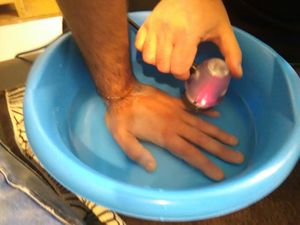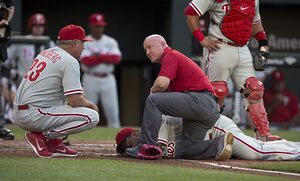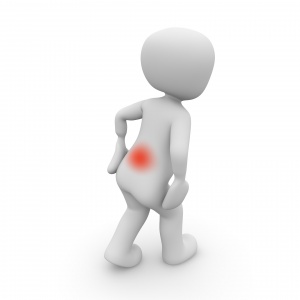Diadynamic Therapy
This article or area is currently under construction and may only be partially complete. Please come back soon to see the finished work! (28/05/2024)
Introduction[edit | edit source]
Diadynamic therapy, a branch of electrotherapy, is employed widely in physical therapy to alleviate pain and stimulate muscle tissues. This therapeutic technique harnesses low-frequency electrical currents, which can produce various beneficial effects on the human body. it is monophasic sinusoidal current was developed in the 1950's,by Bernard (a French Dentist). so it is called also Bernard current.The frequency is operating at 50 Hz with pulse duration 10 msec.[1][2]
There are four different current available for Didynamic current.[3]
- Monophase fixe.(MF)
- Diphase fixe.(DF)
- Courtes periodes.(CP)
- Longues periodes.(LP)
Types of Diadynamic current[edit | edit source]
| wave | Physiological Effect | Indication | Feeling | |
|---|---|---|---|---|
| DF | Full wave alternating current | Has strong analgesic effect for short duration | Pain with muscle spasm | Itching or prickling sensation |
| MF | Half wave alternating current | Stimulate muscle contraction | Pain without muscle spasm | Strong vibration sensation |
| CP | Equal phase of DF and MF are alternating without interval pauses | Stimulate circulation and reduce pain | Traumatic pain | Rapid alternating feeling between DF and MF |
| LP | 10 sec MF followed by 5 sec DF in which intensity and frequency rise then fall | long lasting analgesic effect | Myalgesia\Neuralgia | Strong vibration to little pricking |
Clinical application of Diadynamic current[edit | edit source]
Pain Spot Application:
- Technique: Bipolar technique with the anode applied directly over the pain spot and the cathode adjacent to it.
- Purpose: Directly targets localized areas of pain for relief.
Nerve Trunk Application:
- Technique: Placement of electrodes along the course of the peripheral nerve where it is superficial.
- Purpose: Targets peripheral nerves to alleviate pain and dysfunction.
Para-vertebral Application:
- Technique: Electrodes placed on both sides of the spine at the level of the nerve root supplying the painful area.
- Purpose: Addresses pain and dysfunction associated with spinal nerve root involvement.
Vasotropic Application:
- Technique: Electrodes applied along the vascular paths affected in circulatory disorders.
- Purpose: Improves blood circulation and addresses related symptoms.
Trans-regional Application:
- Technique: Electrodes positioned on opposite sides of a joint.
- Purpose: Targets joint pain and dysfunction by providing stimulation across the affected area.
Mechanisms of Action[edit | edit source]
Combination of Effects:[4]
- Galvanic and Sensory Effects: Diadynamic therapy combines these effects to provide superior pain relief compared to other modalities like direct current (dC), microcurrent electrical neuromuscular stimulation (MENS), and transcutaneous electrical nerve stimulation (TENS) .[5]
- Gate Control Theory: Activation of low-threshold mechanoreceptors (A fibers) and possibly endogenous opioid peptides, contributing to central analgesic mechanisms[6][7] [8].
Effectiveness Compared to Other Modalities:[edit | edit source]
- Greater Analgesic Effect: Diadynamic therapy (ddC) has shown a greater analgesic effect for conditions like TMJ pain, dysmenorrhoea, LBPS, knee OA, and other MSP conditions compared to dC, MENS, and TENS .
- Limitations: TENS may provide deeper analgesic effects in LBPS due to its bidirectional pulsed currents, which penetrate deeper compared to the unidirectional ddC [4].
- Diadynamic current (DD) therapy, alongside transcutaneous electrical nerve stimulation (TENS), has been shown to significantly increase touch sensation, corroborating clinical predictions of the gate control theory. In the study, both DD and TENS effectively enhanced touch sensation over the treatment duration. However, neither therapy demonstrated a significant alteration in pain thresholds (PPT and PPTO), which contrasts with some previous studies indicating TENS' effectiveness in increasing pain thresholds. A notable finding is the significant correlation between touch and pain sensitivity in DD during the third week, suggesting that DD might contribute to a higher analgesic effect over extended treatment periods compared to TENS. This suggests DD may be a viable alternative to TENS for pain management in clinical practice[9] [10]
Application Techniques[edit | edit source]
Bipolar vs. Monopolar Applications:[4][edit | edit source]
- Bipolar Applications: Typically more effective for central analgesic mechanisms .
- Monopolar Applications: Also effective, especially in TMJ pain, due to galvanic effects such as hyperpolarization of nociceptive neurons[11] .
Combination with Other Therapies:[4][edit | edit source]
- Ultrasound (US)[12]: Combining Diadynamic therapy (ddC) with US has shown enhanced therapeutic effects for TMJ pain, heel pain, and LBPS .
- Therapeutic Exercises: Combining Diadynamic therapy (ddC )with exercises reduces pain and improves outcomes in conditions like heel pain and PFPS .[8][7]
Dosage and Treatment Parameters[edit | edit source]
- Recommended Dosage:[4]
- Sessions: Approximately 10 sessions over 3 to 5 weeks .
- Currents: Combining LP and DF currents or using LP current alone .
- Intensity: Sensory-level intensity .
- Duration: 10 minutes per treatment session .
- Electrode Placement: Bipolar application with anode for analgesic purposes and cathode in the treated region for hyperemia .
Indications[edit | edit source]
Diadynamic therapy is often used for:
- Chronic and acute pain conditions[7]
- Muscle strains and sprains ( heel pain[8] ,
- Joint pain and arthritis treatments for joint pain conditions (TMJ pain[13][14], LBPS, PFPS, SPSA, oA and gonarthrosis) and soft tissues (dysmenorrhoea, and cervical MTrPs) that affect the spine, extremities, and head/neck)
- Post-surgical pain management
- Sports injuries (impingement syndrome )[11]
- Neuralgias[15]
Specific Conditions Treated with Diadynamic therapy[edit | edit source]
1. Temporomandibular Joint (TMJ) Pain:Effective in reducing TMJ pain through both bipolar and monopolar applications, potentially by hyperpolarizing nociceptive neurons and activating endogenous opioid systems.[16]
2. Low Back Pain Syndrome (LBPS):ddC can be used as a standalone treatment or in combination with other modalities like ultrasound (US) to reduce pain and improve functionality.Despite good results, it may be less effective than TENS for deeper pain relief due to its limited penetration[17].
3. Patellofemoral Pain Syndrome (PFPS):Combines well with therapeutic exercises, enhancing pain relief and improving joint function.[17]
4. Shoulder Pain (Subacromial):Effective in reducing pain and improving shoulder function when used alone or with other treatments like US.[17]
5. Osteoarthritis (OA) and Gonarthrosis (Knee OA):Provides significant pain relief and functional improvement, potentially more effective than other modalities like TENS .[17]
6. Dysmenorrhoea: Effective for menstrual pain, broadening its application beyond musculoskeletal conditions[17].
7. Heel Pain:When combined with therapeutic exercises, ddC can effectively reduce pain and improve foot function.[17]
Conclusion[edit | edit source]
Diadynamic therapy is a versatile and effective electrotherapy technique used in physical therapy for pain relief and muscle stimulation. Utilizing low-frequency electrical currents, it provides significant benefits across various conditions, including musculoskeletal pain, joint pain, and neuralgias. Its different current types—Monophase Fixe, Diphase Fixe, Courtes Périodes, and Longues Périodes—each offer unique therapeutic effects suitable for specific indications. The therapy’s efficacy, particularly in combination with other modalities like ultrasound and therapeutic exercises, makes it a valuable tool for comprehensive pain management and rehabilitation. Despite some limitations compared to modalities like TENS, diadynamic therapy remains a robust option for treating a wide range of acute and chronic pain conditions.
References[edit | edit source]
- ↑ de Carvalho, A. R., E. M. Fungueto, et al. "Bernard's diadynamic currents and iontophoresis in low back pain treatment (2005).
- ↑ Bolel, K., S. Hizmetli, et al.. "Sympathetic skin responses in reflex sympathetic dystrophy. (2006)
- ↑ Can, F., R. Tandoğan, et al.. "Rehabilitation of patellofemoral pain syndrome: TENS versus diadynamic current therapy for pain relief." The Pain Clinic (2003)
- ↑ 4.0 4.1 4.2 4.3 4.4 Hernán Andrés de la Barra Ortiz, Cristian Jerez Cofré, Cristóbal Vera López, Ignacio Lienqueo Montecinos. Efficacy of diadynamic currents in the treatment of musculoskeletal pain: a systematic review. Physiother Quart. 2023;31(3):1-19. DOI: https://doi.org/10.5114/pq.2023.117021.
- ↑ Benjamin SJ, Flood JN, Bechtel R, Alon G. Measurement of soft tissue temperature and impedance following the application of transdermal direct current. Physiotherapy. 2007;93(2):114–120
- ↑ Rodriguez MJM. Electrotherapy in Physiotherapy [in Spanish]. 2nd ed. Editorial Medica Panamericana; 2005:181–204.
- ↑ 7.0 7.1 7.2 Can F, Tandogan R, Yilmaz i, dolunay E, Erden Z. Rehabilitation of patellofemoral pain syndrome: TENS versus diadynamic current therapy for pain relief. Pain Clinic.2003;15:61–68;
- ↑ 8.0 8.1 8.2 Heggannavar A, Ramannavar P, Bhodaji S. Effectiveness of diadynamic current and mens in heel pain: a randomized clinical trial. int J Physiother Res. 2015;3(2):992–998
- ↑ Ratajczak B, Hawrylak A, Demidaś A, Kuciel-Lewandowska J, Boerner E. Effectiveness of diadynamic currents and transcutaneous electrical nerve stimulation in disc disease lumbar part of spine. *J Back Musculoskelet Rehabil*. 2011;24(3):155-159. doi: 10.3233/BMR-2011-0289.
- ↑ Can F, Tandoğan R, Yilmaz I, Dolunay E, Erden Z. Rehabilitation of patellofemoral pain syndrome: TENS versus diadynamic current therapy for pain relief. *Pain Clinic*. 2003;15(1):61–68. doi: 10.1163/156856903321196519.
- ↑ 11.0 11.1 Gomes CAFP, dibai-Filho AV, Politti F, Gonzalez To, Biasotto-Gonzalez dA. Combined use of diadynamic currents and manual therapy on myofascial trigger points in patients with shoulder impingement syndrome: a randomized controlled trial. J Manipulative Physiol Ther.2018;41(6):475–482; doi: 10.1016/j.jmpt.2017.10.017
- ↑ Morishita K, Karasuno H, Yokoi Y, Morozumi K, ogihara H, ito T, et al. Effects of therapeutic ultrasound on range of motion and stretch pain. J Phys Ther Sci. 2014;26(5):711–715
- ↑ Almagro Urrutia ZE, Santos Solano L, Rodriguez LL. diadynamic and galvanic currents in the treatment of temporomandibular dysfunction [in Spanish]. Rev Cubana Estomatol. 1998;35(3):73–79.
- ↑ Grau Li, Santos Solana L, García J. diadynamic currents and ultrasound in the treatment of temporomandibular dysfunctions. Rev Cubana Estomatol. 1998;35(3):80–85
- ↑ Sims-Williams H, Matthews JC, Talbot PS, et al. deep brain stimulation of the periaqueductal gray releases endogenous opioids in humans. Neuroimage. 2017;146: 833–842
- ↑ Almagro Urrutia ZE, Santos Solano L, Rodriguez LL. Diadynamic and galvanic currents in the treatment of temporomandibular dysfunction [in Spanish]. Rev Cubana Estomatol. 1998;35(3):73-79.
- ↑ 17.0 17.1 17.2 17.3 17.4 17.5 Hernán Andrés de la Barra Ortiz, Cristian Jerez Cofré, Cristóbal Vera López, Ignacio Lienqueo Montecinos. Efficacy of diadynamic currents in the treatment of musculoskeletal pain: a systematic review. Physiother Quart. 2023;31(3):1-19. DOI: https://doi.org/10.5114/pq.2023.117021.











